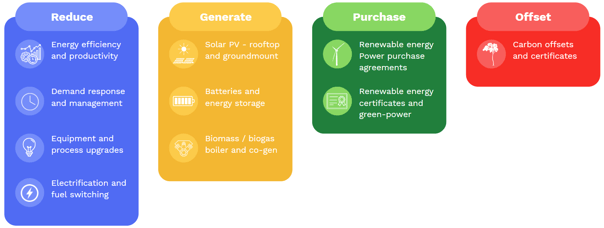Why do you need an energy audit?
Undertaking an energy audit to identify projects that reduce emissions and improve productivity is often the cheapest way to reduce emissions. That is why an energy audit is always the first logical step on the roadmap to zero emissions.
What is the role of an energy audit?
The role of an energy audit is to reduce the baseline or business as usual emissions for which you will need to invest capital in reaching zero emissions.

Typically the cost attributed to decreasing emissions increases in the order shown above – Reduce being the most cost effective and purchase of Offsets being least cost effective. An energy audit will identify projects that are low cost and easily implemented and decrease annual investment in offsets.
For example, Beam recently undertook Level 1 energy audits across a portfolio of aged care facilities and found that a 12% reduction on baseline can be achieved by energy efficiency projects. It is typical that 10 – 20% reduction on baseline emissions can be identified as part of an energy audit.
Projects that can reduce business as usual emissions may include:
- LED Lighting
- Lighting controls
- Air conditioning upgrade or optimisation
- Insulating ductwork
- Install heat pump systems
- Demand response and management
- Variable speed drive control on pumps and compressors
What to expect when engaging an auditor to do an energy audit.
There are three energy audit types as per the Australian standard, a quick reference guide has been developed by the Energy Efficiency Council can be found here. It is recommended that a Level 1 energy audit be undertaken as a first step in identifying projects to reduce baseline emissions as part of a zero emission strategy. This will involve the auditor undertaking a site visit to understand your operations and types of equipment that are used. Along with analysis of the most recent 12 months of energy data, an energy end use breakdown will also be provided.
Projects that are low cost and can be easily implemented will be identified along with an indication of more capital intensive projects that might be considered in the future. Expect savings in a level 1 audit to be broad and based on indicative savings from auditor knowledge and industry assumptions. Economic evaluation will be represented as a simple payback, you can decide which projects are to be implemented and which need further investigation for improved accuracy before seeking quotes from contractors to undertake the work.
Once energy efficiency projects have been identified, other pathways to emission reduction such as Generation via solar PV can be more accurately sized based on the new business as usual emissions. To find the appropriate solar project size for your business – start your assessment here.
Finally, purchasing Offsets is the most expensive path to zero emissions and involves high annual ongoing cost. To see why solar trumps carbon offsets here